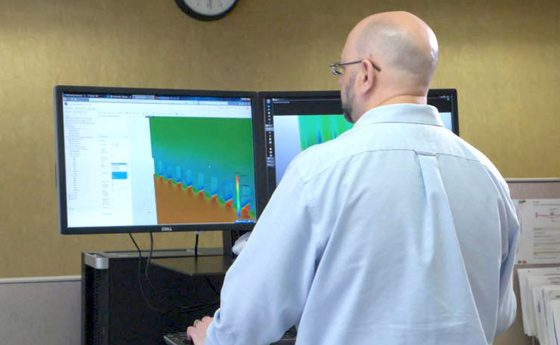If you have kept your finger on the pulse of the architecture engineering and construction (AEC) industry this year, you have heard the words ‘digital transformation’. The term means to encapsulate more than just an industry trend, but rather an imperative for every business to leverage more digital technology and data than ever before, in order to drive business and customer value. For business leaders working in industrial manufacturing, engineering, construction, and design a digital transformation roadmap lays out a reinvention of work processes that involve capturing and utilizing more data across the entire product lifecycle. It asks the question, how can digital technology transform your design workflows, production processes, and overall business operations? How can it redefine your user experience?
Why Is Digital Transformation Important?
Digital transformation ensures that maximum operational efficiency and customer expectations are met. A key element of digital transformation is understanding the potential of your technology —asking what your product is capable of and how processes can be adapted to make the most of technology investments.
One of the most recognizable examples is Netflix whose digital transformation strategy disrupted an entire industry. Netflix enabled libraries of digital content to be accessed through any device with an internet connection, dramatically transforming the video rental business model. Their digital transformation roadmap went beyond product delivery. Examining what else was possible with the technology they were currently leveraging, Netflix continued to grow customer value by implementing an innovative content recommendation system driven by AI.
Customers and clients are responding to a technology-forward approach. A recent study by Salesforce found that 57% of consumers felt it is absolutely critical or very important for companies they purchase from to be innovative and 70% of respondents said new technologies have made switching to competitors easier than ever before.
Likewise, companies are taking note of these shifts in the landscape. While today, organizations find themselves at varying mileposts in their digital transformation roadmaps by 2023, digitally transformed organizations are forecasted to contribute to more than 50% of global GDP.
A Digital Transformation Roadmap for Manufacturing and AEC
What kind of impact can these advancements in tech and business processes have on the AEC and manufacturing industry? According to PwC, 74% of industrial manufacturing CEOs surveyed reported ‘operational efficiencies’ as the main activity for driving growth in the next year. An increase in efficiency, integration, product capabilities, and customer experience can be driven by digitalization. The following guidelines can help structure the first steps of a digital transformation roadmap for engineering and design firms in manufacturing and AEC.
1. Brace for Impact
The evolution in tech is expanding across business operations in virtually every sector. To build an enterprise agile enough to embrace changes and strong enough to mitigate the growing pains you must view digital transformation as a necessary disruption. According to a report from Deloitte, 87% of companies think digital technologies will disrupt their industry, but only 44% feel adequately prepared to weather the changes. Delaying execution on a digital transformation strategy poses a higher risk than those typically associated with disrupting the status quo. In engineering-driven industries, like manufacturing and AEC, which err on the side of risk-averse, this disruption-welcoming posture can feel not only like a digital transformation but a cultural one. Top-down cultural change must be considered to ensure that an organization’s digital transformation roadmap not only accommodates necessary disruption but primes its positioning to seize new business opportunities created by digitalization.
2. The Need for Speed in Your Digital Transformation Roadmap
As the output from AEC and manufacturing industries are typified by longer product life cycles, this can stymie a company’s execution of its digital transformation strategy. But this is precisely why an embrace of technological advancement is key to driving customer value and gaining a competitive edge. Product design processes that can take months, sometimes years, run the risk of failing to keep pace with evolving technology and can be outdated by the time the final prototype is approved. A digital transformation can put tools in the hands of designers to enable rapid innovation efforts, reducing design times and enabling new product capabilities. The agility facilitated by cloud-based tools and integrated, collaborative software prioritizes speed while revealing new insights. The team at Johnson Screens, for example, used SimScale’s cloud-based CFD solution to boost the energy efficiency of radiator grills while reducing time in their design cycle by months. Another example of digital transformation in the production industry is the development of human-machine interfaces. These are intuitive graphic user interfaces with input/output controls that help monitor and efficiently operate complex industrial equipment. Such solutions help uncover industrial system errors 3-4 times quicker and allow operators to take more informed actions, ultimately reducing operational/unit costs and increasing throughput yield.
3. An Interconnected Tech Ecosystem
An internal business transformation, like replacing legacy systems and processes, can come at a high cost so investing in multiple technologies that integrate seamlessly is critical. Digital transformation can be the key to marrying the best of emerging technologies with your business operations. Formerly, extensive hardware investments or specialty hires trained in a particular tool would mean that, without upskilling an entire workforce, new technology could not be leveraged across the entire organization. For example, firms that invest in multiple CAE tools that are only loosely coupled will find themselves often in need of maintenance updates in order for their software to stay compatible. Cloud-based CAE solutions, like SimScale, integrate with other software to form an ecosystem of tools. Architecture firm Thornton Tomasetti developed an in-house digital wind tunnel app by integrating SimScale with Grasshopper to accelerate their building design processes.
4. Make Your Technological Investments Scalable
Similarly, investing in technologies that scale can ensure success in your digital transformation roadmap. Today’s business ecosystems and platforms make it easy for organizations of all sizes to leverage tools that help them grow. Cloud-based platforms and solutions offered “as-a-service” can scale alongside business demand. Companies can capitalize on cross-functional data and shared processes to boost operational efficiency and adapt workflows to growing needs. Zaha Hadid Architects, a global leader in AEC, use cloud-based simulation to adapt their workflows to fit the complex geometries of their projects. Adopt a scalable platform, like SimScale, to help ensure that the processes and information in your company can flow as easily as possible. That’s the foundation upon which everything else can be built.

A digital transformation roadmap is one strategy that enables manufacturing and AEC organizations to embrace and scale digital innovation to improve operating capacities while driving customer value. Cloud-based engineering simulation will be a standard digital transformation strategy unleashed in every designer’s and engineer’s arsenal. Learn how SimScale can help get you there, through cloud-based CFD, FEA, and thermal simulation.
To learn more about digital transformation, explore SimScale’s additional resources on cloud-based tools for innovation:
- Cloud Solution for CAE Simulation
- Digital Transformation Strategy
- What’s the Value of a Cloud-Based Tool for Engineers?
- Cloud Migration in 2020: The New Digital Workplace




